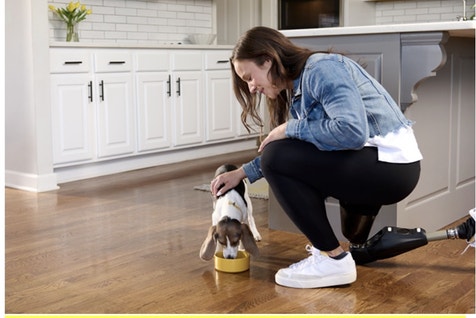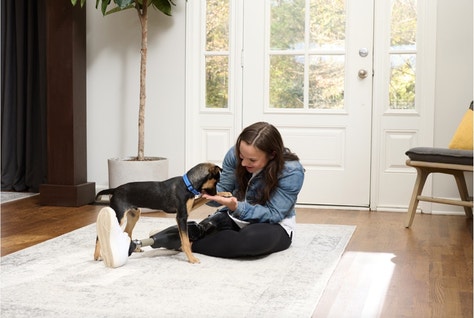
Fur-ever Friends: How to Bond with Your Adopted Dog
Welcoming a dog into your life is just the start of many tail-wagging, face-licking, and cozy couch moments. However, all relationships take work and your bond with your dog is no exception. There are many mental health benefits of owning a dog. Your cute canine companion will be by your side for years to come, seeing you through the good and bad times. Building a strong, lasting connection with your furry friend is essential to ensure a joyful journey together.
We’re here to break down some of our top tips on how to bond with your adopted dog and strengthen that bond over time: from establishing a routine and communicating clearly to making time for walks and play! Through patience, consistency, and plenty of affection, you'll pave the way to becoming the focal point of your dog's world, just as they become the heart of yours.
Establish a Routine with Your New Dog
The initial weeks with your newly adopted dog are important to lay the foundation for a positive relationship going forward. Sticking to a schedule will help your dog feel more secure in their new environment, And the safer they feel, the happier you both will be. Here's how to help ease your furry friend's transition into their new home…
Feeding and bathroom breaks:
Feed your dog at the same times every day and take them out frequently, especially at first. When adjusting to a new home, your pup may need frequent bathroom breaks. Once settled, you will both know how often they may need relief.
Exercise:
Aim for 2-3 walks per day for at least 30 minutes each. Not only does exercise relieve anxiety and pent-up energy, but it's also a chance for bonding. During the walks, talk, play and give treats. Find out what motivates your dog - it could be a favorite toy, lots of praise, or belly rubs.
Training:
Start simple training right away. Focus on basic and important cues such as 'sit,' 'stay' and 'come.' Use positive reinforcement with treats and praise. Keep training sessions short (around 5-10 minutes) and be patient through the process.
A place to call their own:
Give your dog their own space where they can go to feel safe. It could be a crate, bed, or blanket in a quiet area away from activity. Make it cozy and comfortable.Establishing this foundation will set you and your new companion up for success. While it may take a few weeks of consistency, sticking to a predictable routine will help your dog settle in and build trust in you as their caring owner more quickly.
Train Your Dog Using Positive Reinforcement

A well-trained, well-behaved dog earns more trust and freedom. If they respond to your call, they enjoy more off-leash time. When they resist the temptation of food on the table, they can stick around during meals. Training also minimizes frustration as dogs taught specific cues understand your expectations without any confusion or back-and-forth.
Positive reinforcement training is one of the best ways to bond with your dog. Focus on rewarding and praising your dog when they do something you wish to see repeated.
Give your dog treats, belly rubs, and play when they respond to a cue like "sit", "stay" or "come". Say "Good boy!" "Good girl!" or even “Good dog!” in an excited, encouraging tone. Make training fun and help them associate responding to cues with getting rewards and quality time with you.
- Start with basic and easy cues, training for just a few minutes at a time. Don't overwhelm your dog. Keep initial training sessions short and positive.
- Once your dog has mastered a new cue, you can start giving the treat more infrequently when they respond so they don't become dependent on it. PEDIGREE® MARROBONE™ treats are perfect for this activity. Your praise and play will reinforce that they did the right thing.
- Avoid scolding or punishing your dog. Stay patient and focus on rewarding their good behavior. Harsher discipline will likely backfire and damage your bond of trust.
As your dog's skills improve over weeks and months, continue to lavish them with praise, treats and play. Positive reinforcement of their training and good behavior will strengthen your lifelong bond built on mutual affection, respect, and communication.
With consistency and patience, positive reinforcement training helps ensure your adopted dog will become a well-behaved and loyal companion for years to come. Strengthening your bond from the start with encouragement and rewards will make the challenges of the adjustment period easier for you both.
Spend Quality Time Together
The most important part of building a lifelong bond with your dog is simply spending quality time together engaged in activities you both enjoy from cuddling up on the couch to playing in the park. Be patient and consistent, give lots of praise and belly rubs, and you'll be well on your way to many happy years of companionship.
Communicate Clearly
It's cliché advice for a reason: clear communication is key. Misunderstandings and confusion can harm your relationship, so strive for clarity when interacting with your dog. Maintain consistency in your training signals. Since dogs often pick up visual cues more quickly than vocal ones,
prioritize using gestures when possible. Remember, dogs pay more attention to your actions than your words, so be mindful of your actions during communication. Strengthen your bond by fostering a better understanding between you and your furry friend.
Be Playful
Embrace a playful attitude. Scientific studies indicate that, in various species, the strongest parent-child relationships stem from playful interactions. And the human-dog bond is no exception. Strengthen your connection by enjoying activities together.
Tap into your dog's innate instincts for chasing, catching, and playing by investing time in interactive dog toys such as balls and frisbees. Initiate games like fetch in your yard or at a dog park. Share laughter, offer belly rubs, and communicate with an animated, playful tone. Your dog will appreciate the attention and mental stimulation.
Remain Calm and Patient
Nobody likes to be scolded or yelled at, and that includes our pets. Whether you're training your pooch or just communicating with them day-to-day, displaying anger, raising your voice, or reacting dramatically will disturb them. Regardless of the situation, project a calm presence so your dog can rely on your ability to remain composed and know they are safe.
Do Your Research
Explore dog behavior particularly when interpreting body language and facial expressions that signal stress. Recognizing signs of anxiety or fear in your dog allows you to safeguard or remove them from unsettling situations effectively. By ensuring your dog feels secure in your care, you strengthen the trust between you, ultimately enhancing your relationship. Seek out books from positive-based trainers for more information, tips, and tricks.
Get to Know Your Dog's Likes and Dislikes
As with anyone important in your life, it's good to find out what your furry friend does and doesn't like; that way, you can provide more of what they love (tummy rubs, treats, playing) and avoid things they don't. For example, most dogs will find it unnerving to be stared at, may be scared of loud noises, and will hate wearing clothes that make it hard to move. Some dogs also dislike citrus or strong floral scents, head pats, and (yes, sadly!) even hugs.
Pet and Groom Your Dog
There's solid proof that giving your pup some physical TLC, like grooming and petting, can help to chill them out. This shows up in things like a slower heart rate, a reduced stress hormone (cortisol), and a boost in the feel-good hormone oxytocin. Scientists say it's a legit way to strengthen the bond between you and your furry friend.
Go on Plenty of Walks
Table of Contents

Make walks an everyday adventure! Explore different routes, let your pup sniff around, and enjoy the outdoors together. While strolling, chat with your furry friend in a friendly and upbeat tone. Shower them with praise and toss in some tasty treats to show that walks are all about good times and rewards. As you make these walks a regular thing, your dog will start associating the sheer mention of "walk" with pure excitement. It's like creating a special language between you and your canine buddy.
These are some of our key tips for forging an unbreakable connection with your newly adopted dog. Show them patience, love, and consistency from day one. Make training fun and help build their confidence. Give them space when needed and show interest in the little details that make them who they are. If you commit to bonding with your dog in this way, you'll find a faithful friend for life. Before you know it, you won't remember what life was like without them.




